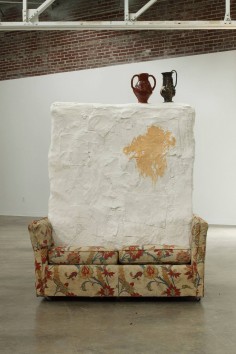jessica jackson hutchins
Couch For A Long Time
source: saatchigallery
The title of Couch for a Long Time, Jessica Jackson Hutchins’ mixed media sculpture, implies a kind of indolence, a suggestion of idling, and the colour-streaked ceramic pots and sculptures seem to sit on the receiving cushions of their newspaper- clad couch like lazy characters in front of an absent TV. The physicality of the ceramic pieces’ forms – their bone- or flesh-coloured glazed surfaces, their bottom- heavy fatness – invokes the human body; even the couch itself, its cushions bulging like tongues in reaction to its occupants, has a
bodily fatness, a subservience to gravity. By contrast, the couch’s surface, covered with newspapers, implies a different temporal idea: the speed of a news story, its sudden irrelevance. That the newspaper clippings repeatedly refer to the then-incumbent President Obama gives these parallel speeds added poignancy. Differing rates of change – the ceramic pieces, protected by a sheen of glaze, will remain intact for as long as they’re carefully held; both the material and the content of the newspapers become dated almost immediately after they’re printed – gives the title additional meaning. Obama became a vessel for certain ideas of optimistic change after the Bush presidency; debatably, those ideas have dated, even lost their lustre. The couch, too, accrues meaning by association: once in Hutchins’ childhood home, its newspaper covering is a kind of protection, as though the room around it were being painted. That, and the preservation implied by the vessels, gives Hutchins’ piece the gravitas of a domestic monument, to be remembered – with a kind of sad hope – for “a long time”.
.
.
.
.
.
.
.
source: icabostonorg
Jessica Jackson Hutchins (b. 1971, Chicago) transforms life into art, creating sculptures and collages from everyday objects. With the addition of ceramic and papier-mâché, her family’s kitchen table and living room furniture, along with her favorite pieces of clothing and books, become works of art. A couch is no longer a couch, but a pedestal for sculpture. The rituals of quotidian use linger and infuse Hutchins’s work with charged sentiment. The tension between art and the stuff of life prompts us to think about her formal choices as well as her subject matter. Hutchins has said, “Transformation, evidence of work, accidents, the time contained in the humanity of the objects—all that stuff is crucial to get at what I’m trying to get at, which is ways of connecting to the world, ways of knowing ourselves through the things we encounter.”
This exhibition, Hutchins’s first solo presentation in a museum, showcases Symposion, a large sculpture whose title is the classical Greek word for “drinking party.” The attendees of a symposion shared not only wine, but food, sex, and, most importantly, speeches. Symposion marries exuberant abstract form with a shabby sofa. Hand-built ceramic pots nestle among the crevices of a gargantuan black papier-mâché form that haloes the peacock-blue couch. The bulbous form—both monstrous and sublime—recalls imagery as varied as the massive reclining nudes of English sculptor Henry Moore and ancient Greek pots decorated with drawings of revelers lounging drunkenly on chaises. This exhibition also includes several drawings of punctuation—commas, exclamation points, and question marks—created from lumpy paper pulp, paper coffee cups, and spray paint and watercolor. If the symposion was a place to deliver speeches, then the drawings offer another kind of arena. The fields of punctuation marks suggest a narrative, but one without discernible plot.


